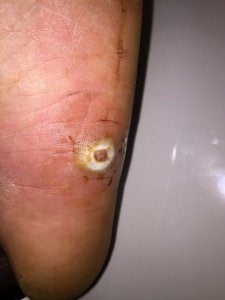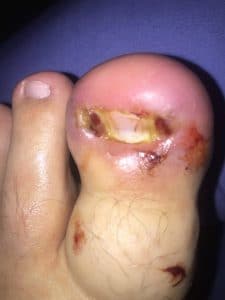Cellulitis

What is Cellulitis

Cellulitis, like any other infection, can become a medical emergency if not treated quickly. This can usually be done using common antibiotics. Consequently most patients make a full recovery. The initial stages of infection are silent as the bacteria multiply. Signs and symptoms then begin to appear. These include visible redness, a feeling of warmth, pain or discomfort.
Who Gets Cellulitis
Almost any person can develop cellulitis at any time. Certain people are at an increased risk, however. These include:
- Diabetics. Patients with diabetes are more at risk for some types of infections. Cellulitis among diabetic patients often appears on the lower legs, ankles, and feet.
- Skin damage. The bacteria which cause cellulitis need broken skin in order to enter the body.
- Vein disease- Patients with long term vein disease (reflux) are more ar risk to cellulitis and other infections. This is due to skin changes which can occur as blood pools in legs over months or years.
- Other circulation problems. Those with Peripheral Artery Disease (PAD) often have decreased blood flow to the legs and feet. This can also make a patient more prone to infection. Chronic vein disease is one example.
- Chronic liver disease.- This mostly refers to liver infection (hepatitis) and scarring of the liver (cirrhosis).
- Other active skin conditions. -Psoriasis, eczema, and even chicken pox all increase the risk of cellulitis.
- Open sores or other skin defects. -These allow bacteria to enter the skin, just like a small nick or cut. Splinters and other foreign bodies can also easily push bacteria deep into the skin to cause infection.
Signs and symptoms of cellulitis:

Many of the signs and symptoms of cellulitis are actually the body’s immune response to the infection. No two patients or infections are exactly alike, yet the following are almost always present:
- Swelling
- Tenderness or pain
- Erythema (redness)
- Warmth
- A colored or clear discharge (less common)
- Drainage (the presence of pus, less common)
Cellulitis as a medical emergency:
An infection begins any time bacteria grows on or in the body. The body’s immune system is overcome. This makes sense. In conclusion, if the bacteria had been destroyed initially they wouldn’t multiply. Subsequently no infection would occur.
Most importantly, any infection can become a medical emergency. Above all, seek immediate attention if you or your Podiatrist notice any of these:
- Red streaks leading away from the initial site of infection.
- Nausea / vomiting.
- A high fever.
- Severe pain.
- Increase in swelling or a “hardening” of the area.
- A foul-smelling discharge
- Numbness or other sensory changes
Cellulitis making the diagnosis:
Above all, this common infection is well known to a most Podiatrists. Consequently, it is easy to diagnose. First your doctor begins with a medical history and physical exam. Many times the signs and symptoms they note are all that’s required to make a diagnosis. Therefore, this process is known as making a clinical diagnosis. In addition, if there’s any doubt then tests may be ordered:
- Complete blood lab testing
- An X-ray exam -if your podiatrist believes splinter or other foreign body is inside.
- A culture if you need to know the precise type of bacteria involved.
Can cellulitis be a recurrent condition, and if so, why?
Yes, cellulitis can be a recurrent condition for some individuals. This may occur due to several reasons:
- Incomplete Treatment: If cellulitis is not completely treated the first time, residual bacteria may persist, leading to a recurrence.
- Compromised Immune System: Individuals with weakened immune systems, due to conditions such as diabetes or HIV, are more susceptible to recurrent cellulitis.
- Lymphedema: Swelling of the limbs, known as lymphedema, can make individuals more prone to cellulitis recurrence.
- Skin Conditions: Pre-existing skin conditions, like eczema or fungal infections, can create openings for bacteria to enter, increasing the likelihood of recurrent cellulitis.
- Peripheral Vascular Disease: Poor blood circulation can contribute to recurrent cellulitis, as it impairs the body’s ability to fight infections effectively.
- Environmental Factors: Exposure to environments with a high prevalence of bacteria, such as certain workplaces or living conditions, can contribute to recurrent cellulitis.
How does cellulitis affect different age groups, such as children or the elderly?
Cellulitis can affect individuals of all age groups, but its impact may vary based on age:
- Children:
– Children are susceptible to cellulitis, often due to cuts, scrapes, or insect bites.
– Prompt medical attention is important to prevent complications and ensure proper healing.
– The condition is generally responsive to antibiotics.
- Adults:
– Adults may develop cellulitis from skin injuries, surgical wounds, or underlying conditions.
– The likelihood of complications increases in those with compromised immune systems or chronic illnesses.
- Elderly:
– The elderly are at a higher risk due to weakened immune systems and reduced skin elasticity.
– Chronic conditions, such as diabetes or vascular issues, can contribute to cellulitis in older individuals.
– Prompt diagnosis and treatment are crucial to prevent complications, especially in the presence of comorbidities.
Can Cellulitis Cause Permanent Skin Damage?
Yes, it’s possible for Cellulitis to cause permanent skin damage, especially if your condition is severe. Most Cellulitis will heal without any long-term changes, but there are chances of complications that can lead to scarring, skin discoloration, or chronic swelling if the lymphatic system is damaged. But if the conditions are too serious, and you have infection then it can even lead to tissue necrosis which is death of skin tissue. This will later lead to ulcers or open wounds, that can indeed do some permanent damage to your skin and can be fixed with skin grafting only. Even worse can happen if the infection enters your bloodstream, as it will increase the risk of long-term damage, which will surely lead to some permanent damages.
What Happens If Cellulitis Is Left Untreated?
Leaving Cellulitis untreated is probably the last thing you would want to do because it will allow the infection to spread deeper into the skin and bloodstream as mentioned earlier. Which later leads to many dangerous complications such as skin necrosis, a condition where skin tissues die, or sepsis, which is a life-threatening where infection successfully enters bloodstream and streams infection everywhere into the body. In severe cases, the untreated Cellulitis even has chances to affect muscles, bones, or vital organs, which will surely require hospitalization at one point. Which is why it’s important to get the early treatment!
Can Cellulitis Cause Fever and Chills?
Yes, it’s possible for Cellulitis to cause fever and chills, as these are signs of infections, which means if you experience them if you have been infected already. When the infection has spread beyond the skin the body responds with an immune reaction which causes symptoms like high fever, chills, fatigue and sweating. Such cases require urgent medical attention, so do not ignore such signs!
